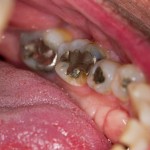
Replacement of defective restorations is the commonest procedure carried out in general dental practice. Replacement generally means some further loss of tooth substance and enlargement of the restoration. Alternatives to full replacement have improved restorations and increased longevity. The aim of this study was to estimate the median survival time (MST) of marginal sealing, repair and refurbishment of amalgam and resin-based composite restorations with localized defects as a treatment to increase the restoration longevity.
A cohort of 66 patients, with 271 class I and II restorations clinically diagnosed with localized defects was followed longitudinally. Restorations underwent one of the following procedures: Marginal Sealing (n=48), Refurbishment (n=73), Repair (n=27), Replacement (n=42) or remained Untreated (n=81). At 4 years 52 patients with 208 restorations were available for assessment in the following groups Marginal Sealing (n=36), Refurbishment (n=63), Repair (n=21), Replacement (n=28) and Untreated (n=60).
The restorations were assessed at baseline and annually during 4 years using the modified Ryge criteria by two calibrated examiners. The Kaplan Meier test indicated that after 4 years of follow up , the Sealed margins group showed the lowest MST while the Repair group showed the highest.
They concluded that:-
Defective amalgam and resin-based composite restorations treated by sealing of marginal gaps, refurbishment of anatomic form, luster or roughness, and repair of secondary caries lesions, had their longevity increased.
Fernández EM, Martin JA, Angel PA, Mjör IA, Gordan VV, Moncada GA. Survival rate of sealed, refurbished and repaired defective restorations: 4-year follow-up. Braz Dent J. 2011;22(2):134-9. PubMed PMID: 21537587.
